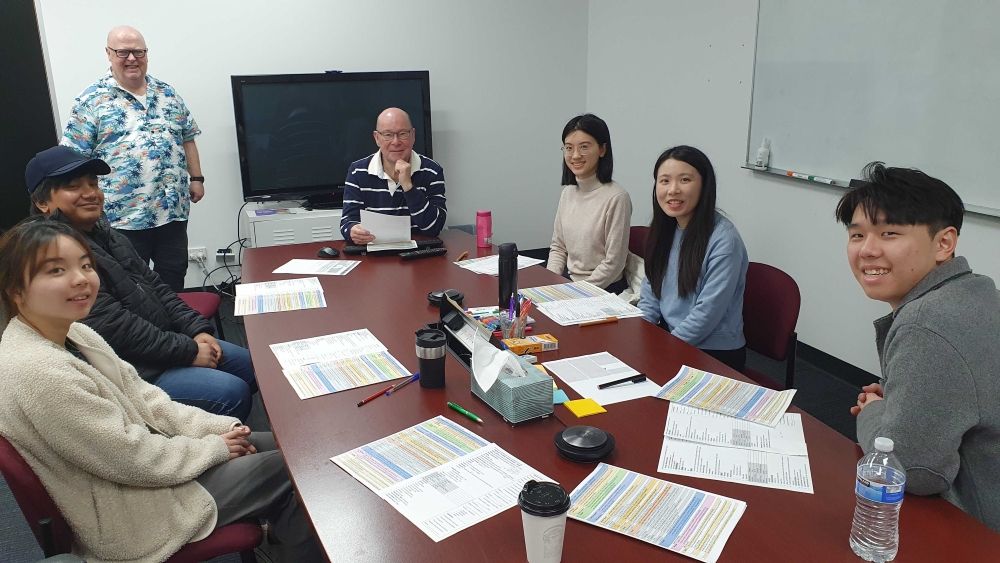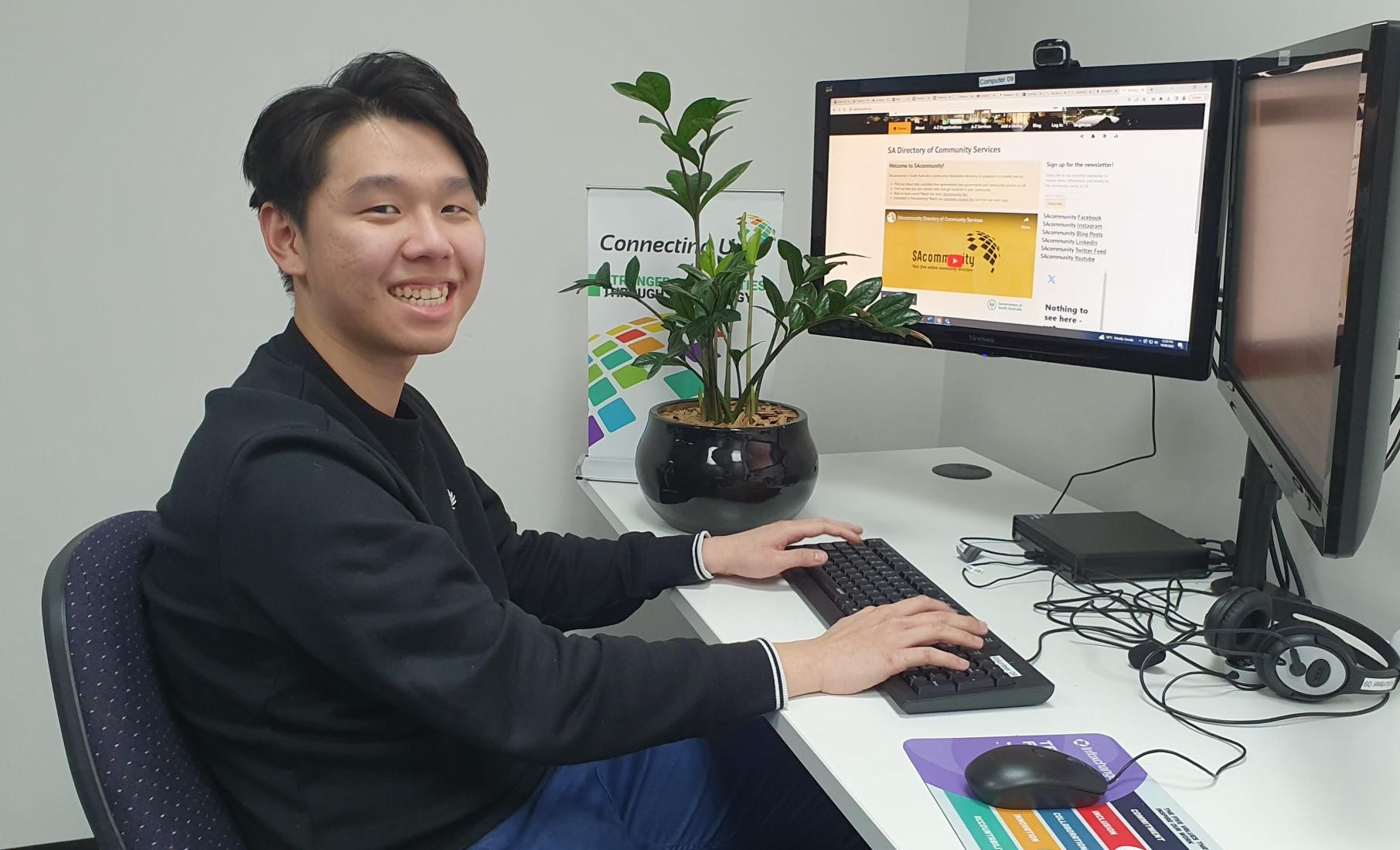Looking ahead, he aims to continue to follow his two key interests. On one hand, he is passionate about music and wants to use its power to connect and uplift communities. On the other hand, he is drawn to air traffic control, where he can ensure safe skies and contribute to global connectivity. These goals might seem different, but both require attention to detail, quick thinking, and effective communication. He is excited to pursue his journey in both fields to create a fulfilling and impactful future.
 David Webb Leading a Telephone Techniques Session.
David Webb Leading a Telephone Techniques Session.
Intern Grace Hong Hong, Volunteers Pujan Maharjan, Rex Porter (Information Management Team), David Webb (Customer Service Team), Thea Shiye Jin, Alice Jinye Zeng and Michael Pak Hei Chan
Training and Development - Telephone Techniques
Telephone techniques are critical in the SAcommunity Customer Service Team, making important connections with community organisations by phone, email or online and collecting information on the services they provide. Contacting not-for-profit and charity organisations is an important aspect of understanding data collection methods for inclusion into the SAcommunity directory.

Image: Sam Lloyd, Marketing Lead Infoxchange and Volunteer Michael
Mentor Meeting
Connecting Up Volunteers are provided with the opportunity to select staff members from across the wider organisation for an informational mentor meeting. In this meeting they have the opportunity to ask career and professional development questions to understand more about their job role and employment journey, before recording those aspects they felt were helpful for them to share on their portfolio for themselves and other volunteers, and Michael shared his experience in meeting
Sam Lloyd, Marketing Lead, Infoxchange below.
On February 7, 2024, Michael met Sam Lloyd, the Marketing Lead of Infoxchange, as part of the Mentor program. Sam is an expert in his field with experience in marketing and communication, and I asked him about career advice and marketing tactics during our meeting.
Key takeaways:
Sam Lloyd graduated with a Music degree, he started a Bachelor of Communication and deferred after gaining work full-time in the field. I asked about how he pivoted from Music to Marketing? And what was it like to work in an industry you are passionate about, is it still interesting to you when you work in the job everyday?
Firstly, he explained “Don’t ever be tripped up by what you have formally learned, be open to learn anything, in any field.” Secondly Sam highlighted this by mentioning, “You might lose your passion when your interest turns to a job or study, so be open for everything.”
What is the most important key to successful Marketing?
“There is always a very important question I will ask myself when I have to sell a product which is: ’Who Cares?’ Sam said. “It is very important to find the correct audience when selling a product. You can’t sell a brilliant coffee machine to a person who doesn’t drink coffee at all. Even if the coffee machine makes the finest coffee in the world, it still wouldn’t attract people who are allergic to coffee.”
Can you apply your Marketing tactics to your personal life?
“Yes, you can." Sam explained, "However, I wouldn’t do that because I don’t want my personal interest to become too commercial. For example, my rock band holds shows quite often, but I wouldn’t use my marketing skills to promote them because I just want to enjoy playing at the shows and relaxing in my own time. in addition, keeping yourself balanced is also important, it heals you mentally and improves your working efficiency."
What is good Marketing? How do we know we are on the right track?
Sam advised Michael to look at the 10 Step Marketing method:
1. Marketing orientation - Remembering that this is about the customer. Ask yourself: Who cares? And: Why should they care? Start with “why” and focus on “why”, not “what” or “how”. ALWAYS start with orienting yourself and your team/company/product to the customer first.
2. Market Research - learn who your market is, what they care about, what drives them (find out their “why”). Scope out your competitors and analyse their strategy and tactics, see where they are succeeding and failing.
3. Segmentation - divide your audience up into meaningful segments based on the attributes that relate to “why” they should care about your offering. Don’t use generic, meaningless segments (e.g. “Millenials”, or “women interested in sports”).
4. Targeting - decide which segment/s you are going to reach out to. Choose the targets you can reach the easiest and in the most cost-effective manner.
5. Positioning - this is about the “position” you want your product to have in the customer’s mind. When someone thinks about your product, which part of their mind do you want it to be in? The “classy” part? The “sporty” part? The “fun” part? Also – where do you want it to be positioned in relation to your competitors? Above? Below? Besides? Etc.
6. Objectives - setting goals and the metrics by which you will measure success. Make them SMART goals (Specific, Measurable, Achievable, Relevant, Time-bound)
7. Product - understand and establish what your “Product” is. In this sense, a product could be a physical product, or a service, or a training course, or an e-book – if you’re offering it to someone, it’s a product. Define your product in terms of core benefits that connect to the customer’s “why”, and how the product helps the customer with their “jobs to be done”.
8. Price - again, we have less control over this than we used to, but the price needs to be set with our targeting and positioning in mind. The price needs to communicate the value of the product. Your market research should inform your price as well. It’s not just about “making X% margin”. Your price is a value communicator.
9. Promotion - this is where you choose which channels you are going to send your message through. If you’re using more than one (and you always should), make sure your message synergises and is recognisable as the same campaign.
10. Place - how you will deliver the product to your customers in a manner appropriate to the customer’s needs, and also the most cost-effectively. For physical products, this will involve which physical stores they will be sold in and touch on logistics and supply chains. Again, the method or place of distribution is a value indicator. Supermarket VS high-end store VS online only, etc.
Have you ever been in a situation where you used the wrong marketing strategy and didn't have a good response? What did you do next?
Sam shared that he once passionately promoted a product he believed everyone would love, only to be disappointed by the outcome. Reflecting on this, he realized the importance of targeting the right audience. Since then, he always reminds himself to focus on finding buyers who genuinely “CARE” about the product, ensuring better results in his marketing efforts. (CARE = Customer Focussed, Authentic, Relevant and Engaging)
 Image: Michael performing for the Hong Kong Cultural Association, his article on the club can be found >>here influenced his interest in Connecting Up's Digital Marketing Training
Image: Michael performing for the Hong Kong Cultural Association, his article on the club can be found >>here influenced his interest in Connecting Up's Digital Marketing Training
Training and Development - Digital Learning Platform
Connecting Up runs a number of
Training and Education Programs and SAcommunity interns and volunteers are provided with access to the
Connecting Up Digital Learning platform for webinars, online workshops, masterclasses, and bootcamps, providing opportunities to learn about a range of tech-based tools and strategies from subject experts, designed for the needs of nfps the topics are helpful for all those looking at improving their digital literacy and range from Microsoft tools to marketing.
Professional Development at Infoxchange is a balance of approximately 70% project / 20% peer-to-peer learning / 10% formal learning. For the SAcommunity Team there is approximately 15 hours of project work, 3 hours of peer-to-peer learning, and 1 hour of online webinar with 30 minutes of feedback, to reflect and strengthen team members understanding of what was learnt, and what their personal takeaways were from these educational sessions facilitating life-long learning which are added to their portfolio.
Relevant webinars, workshops and webcons selected by Michael have included:
My decision to undertake the
Digital Marketing Webcon 2022 was driven by a desire to enhance my understanding of how to promote organizations, stemming from my involvement with the
Hong Kong Cultural Association of South Australia and my personal rock band. Admitting a lack of prior marketing knowledge, I found the webcon to be a valuable resource for grasping the basics of Digital Marketing.
My particular interest is in digital promotion and learning more about good design principles for posters, and I selected this webcon for the third session with the anticipation of gaining insights into using Canva. Particularly as I previously faced challenges in reaching targeted audiences and struggled with creating compelling posters or graphics to attract people to various events and activities I have been involved with. The webcon, therefore, serves as a catalyst for my growth in the realm of digital promotion, providing me with the knowledge and tools needed to overcome my previous challenges and effectively promote the not-for-profit organizations and causes I am passionate about.
The webinar introduces the fundamental principles of digital organizing using Nation Builder. It covers essential concepts like organizing and storing data, along with strategies for engaging audiences. By attending this webinar, participants gain a clear understanding of digital organizing, equipping them with the knowledge to engage with communities effectively and build lasting relationships. This session is particularly beneficial for beginners, as it delves into the foundational aspects of digital practices, providing a solid starting point for navigating the contemporary digital landscape.
This session explained social media is a powerful tool to grow and activate customers or cause communities around your organisation, like Facebook and Linkedin are the best platforms to connect and deliver. Step by step teaching the convenience of using social media to gain your connection with targeted communities, such as using Facebook groups to connect and activate your audience. Demonstrated an example for beginners to reach out to an audience by using social media, also shows the efficient way for intermediate people that want to use this tool to gain more from the media world nowadays.
In this session, a perfect example was shown to create fantastic marketing materials and social media posts using Canva. It highlighted that even with limited experience, resources, or budget, Canva can assist users in producing professional-looking outcomes. The presenter guided the audience through the process, emphasising how easy it is to create with confidence in a short time. This session is particularly beginner-friendly, making it accessible for those who are new to designing but want to make impressive posters and graphics.
In this session, the primary focus was on social media advertising. The discussion emphasised the importance of having a clear plan and strategy for paid advertising to avoid spending money without achieving meaningful results. The session delved into the intricacies of advertising planning, ad structure, and provided guidance on creating the first ads from scratch. The key takeaway for me was the significance of crafting ad content that effectively communicates the intended message to the targeted audience, ensuring a purposeful and successful advertising investment.



 Image: Michael performing for the Hong Kong Cultural Association, his article on the club can be found >>here influenced his interest in Connecting Up's Digital Marketing Training
Image: Michael performing for the Hong Kong Cultural Association, his article on the club can be found >>here influenced his interest in Connecting Up's Digital Marketing Training



